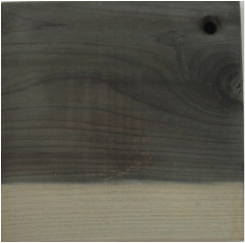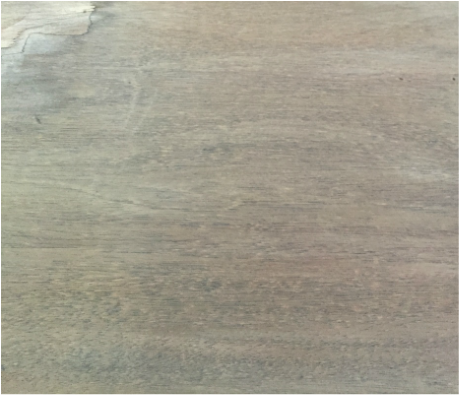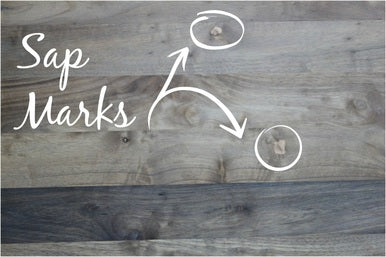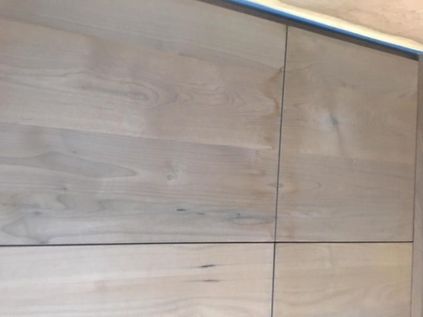How to Apply W▴W STAINS
You can watch our video series, or simply follow the instructions below.
In general, Weatherwood Stains' application is similar to other stain- except for 2 things-
[1] Apply a generous coat of stain.
[2] The stain should not be applied and wiped back off. Apply it and walk away!
PRETREATING
- Mix stains well before and during use. Strain before use.
- Stains will react with the tannin in your wood, so test stain on a scrap of wood to ensure color before completing project.
- Do not work out of large container of stain, pour what you need into a plastic container and tightly seal lid afterwards.
- Do not put into contact with metal of any kind. Especially do not store in metal containers.
- Do NOT apply in temperatures below 50 degrees.
- Use a new brush. Do not cross contaminate your stain by using a brush or any other material that was used on a pigment based product!
- You can water-pop wood before staining, for deeper penetration.
- Do not use pre-treaters like wood conditioners or primers, these can close the wood pores and minimize stain reaction.
- Stains do do not require ventilation, do not contain toxic fumes, and can be applied indoors without harm to the applicator.
- Stains are NOT dangerous to plants, or the ground. Stains CAN be applied on site in exterior settings, but will stain concrete.
- Stains will stain clothing, floors, concrete, etc. Prepare and protect surfaces around project.
SANDING
New/Raw Wood
- Sand wood with between 60-80 grit, to make sure the wood is opened up. Do not sand over 120 grit before applying stain, or color will be altered.
- Sanding is not necessary with rough cut, wirebrushed, rough sawn lumber, or other opened up wood surfaces.
Previously Stained/Finished Wood
- Wood should be stripped and/or sanded of previous finishes. You can use chemical strippers with Weatherwood stains, but make sure to sand afterwards, to remove any chemical residue. Sand using 60-80 grit, to make sure the wood is opened up. You can see above, you must sand down to raw wood removing all of the preexisting finish.
APPLICATION
PAINT BRUSH APPLICATION
BRUSH or RAG
- Do not work out of the container. Pour what you need into a separate container and keep original tightly sealed.
- If purchasing several separate containers, pour them into a larger container to ensure batch and color consistency.
- Use new foam brush, synthetic paint brush, or clean rag. Foam brush will give you best results on smooth wood (besides using a paint sprayer).
- Apply an even, generous coating of stain.
- Remove any long standing puddles or any bubbles from the wood using a wet brush.
- Allow to air dry. Hardwoods take ~30 minutes, softwoods ~60 minutes.
SECOND COAT
- When refinishing wood, a second coat of stain is generally recommended to achieve the wood's darkest shade.
- You may apply a second coat of stain if you wish. Depending on the stain type, a 2nd coat can darken your wood species, but this is on a case by case basis. See information under each stain color for specifics.
SUBMERGING WOOD (OR FLOOD SYSTEM)
SUBMERGING/FLOOD SYSTEM
- Do not work out of the container. Pour what you need into a separate container and keep original tightly sealed.
- If purchasing several separate containers, pour them into a larger container to ensure batch and color consistency.
- If you are using an assembly line, flood system, or vat you can apply Weatherwood Stain's by submerging wood into the stain.
- Make sure the lines are completely clear of traditional based stains. Flood system must be run completely clean prior to use, or color will be altered.
- Experimenting is key here to obtain your color. The longer they're dipped, the darker they will get up to each wood's limit. Different wood types should be submerged longer or shorter, to get wood to its darkest shade. In general, hardwoods need submerged lesser time, 3-5 seconds, while soft woods may need to be dipped longer, 5-20 seconds.
- Leaving wood in too long will result in water marks so some trial and error should be expected.
- Remove any bubbles from wood's surface using a curtain flood system or a wet brush. Otherwise stain cannot penetrate.
- No not wipe off.
- Pull out handling wood by the edges and allow to air dry in racks. Do not stack wet wood on itself.
SECOND COAT
- When refinishing wood, a second coat of stain is generally recommended to achieve the wood's darkest shade.
- You may apply a second coat of stain if you wish. Depending on the stain type, a 2nd coat can darken your wood species, but this is on a case by case basis. See information under each stain color for specifics.
SPRAYER APPLICATION
SPRAY GUN
- Do not work out of the container. Pour what you need into a separate container and keep original tightly sealed.
- If purchasing several separate containers, pour them into a larger container to ensure batch and color consistency.
- Weatherwood's Stains are the viscosity of water. Mix and strain wood stain before loading into the sprayer.
- Use an atomized spray gun and air compressor, 8 lbs, 2.5 hp, 8 gallon, 90 PSI.
- Open the nozzle completely, so that when you spray the gun you can easily drench the wood's surface.
- Apply a heavy spray coat, drenching the wood's surface. Typically 6-8 consecutive passes with the gun is sufficient.
- Pay close attention when spraying to make sure it's heavy enough to wet the wood and overlap the passes enough to avoid spraying stripes. This application will make your product go the furthest.
- No not wipe off. Allow to dry.
SECOND COAT
- When refinishing wood, a second coat of stain is generally recommended to achieve the wood's darkest shade.
- You may apply a second coat of stain if you wish. Depending on the stain type, a 2nd coat can darken your wood species, but this is on a case by case basis. See information under each stain color for specifics.
DRYING
The oxidizing process and color change is complete when the wood is totally dry.
Dry time varies from 30 min - 2 hours (floors) depending on wood softness, climate, and project. The wood species, wood softness, and cut of wood influence dry times. Softer woods take longer. Bigger projects, like floors, have a longer dry time.
Drying is sped up by air circulation and warm temperatures. Drying is slowed in humid climates and low temperatures, near 50 degrees.
FINISHING
We recommend using Weatherwood topcoats, as they are specially formulated to control and maintain our weathered colors. Because we are oxidizing the wood and not staining it, keeping the exact stained color can be tricky. All topcoats slightly darken stained wood, that's just the nature of wood. But you can minimize that darkening by using our topcoats. Find more product info -here.
INTERIOR USE:Our reactive stains are only wood stains, they do NOT protect for oils, foods, etc. For interior use, our Weatherwood Topcoats should be used to both protect the wood and the color.Some suggested topcoats for maintaining the weathered look.
- TO DARKEN THE LOOK & FOR OILED FLOORING: Weatherwood Maintenance Oil Clear
- TO LIGHTEN THE LOOK & FOR OILED FLOORING: Weatherwood Maintenance Oil White
- FURNITURE, CABINETRY, MILLWORK: Weatherwood Varnish Topcoat
- HARDWOOD FLOORS: Weatherwood Polyurethane Topcoat
EXTERIOR:For exterior use, our Weatherwood Exterior Waterproofer is needed to both hold the Weatherwood stained look and protect the wood itself. Weatherwood Exterior Waterproofer will protect wood itself from the harmful effects of harsh weather conditions, like cupping, splitting and twisting. Some Weatherwood Stains products DO have a UV & water resistance built in.
- EXTERIOR PROTECTION: Weatherwood Exterior Waterproofer
You will find numerous examples of our topcoats on different species on our youtube channel
HARDWOOD FLOORING APPLICATION
-
Materials for Hardwood Floor Application:
- Paint Sprayer
- Long-Handled Brush
- Squeegee
- Lint free cloth
- Plastic Gloves
-

Paint Sprayer
-

Long handled brush
WOOD PREP
- Sand the floors and vacuum the dust. Sanding between 100-120 grit. 220 grit may seal the wood and keep floors from "taking" the stain.
- To open the grain, the suggested method is water popping them.
- Stains themselves typically do not pop the grain.
- Do not precondition or pretreat the wood. Bleach may affect the final stain color, so test color FIRST.
- If using several containers of Weatherwood stain, mix into a larger bucket before applying.
- Mix stain well before and during use to ensure consistency.
METHOD 1: Tools: Use an empty 5 gallon bucket and a long handled broom. Using this method 1 or 2 person's can work together. STAIN PREP
- Pour all your stain into the 5 gallon bucket.
APPLICATION
- Edge section of the floors using a brush or large sponge brush.
- Dip the broom into the bucket and lightly push the stain into the wood grain, cracks, and grooves. Unlike most waterborne finishes, the goal is not to wipe on and wipe off, but rather you should flood or drench the wood's surface and then allow the wood to absorb the stain.
- Work in sections, a few planks of wood at a time. Either tape off the floor into sections or keep a wet edge as you work across the floor, this will avoid overlap marks.
- Work the length of the wood plank. Do not stain half a piece of wood and then come back to stain the other half. Like regular stains, it will be difficult to blend the stain if the product dries mid board, and then you add more stain to the other half.
- See above video for additional information.
DRY TIME
- Floors will dry within 2-4 hours, drying is quickened in warm environment with good air flow.
TROUBLESHOOT
- As the wood dries, if raw wood spots of occur, it's important to fix them while the floor is still wet. Using a wet brush to blend with stained areas.
- If foam/bubbles are caused by wood stain agitation, remove them from the wood's surface with a wet brush. Don't leave them to dry.
- If a puddle looks to be long standing (from uneven floors) use a wet brush to remove it.
- Allow wood to dry fully before applying topcoat.
METHOD 2:
Tools: Use a stain sprayer and a long handled broom or squeegee to equalize. When applying Weatherwood Stains to hardwood flooring it's best to work in a two person team. The team works in sections- one with a sprayer and the other with a brush/squeegee.
STAIN PREP
- Pour all your stain into the stain sprayer gallon bucket.
APPLICATION
- Person 1: Beginning at the furthest corner of the room work in sections 6-12 feet long. Using the sprayer, apply a 4-6 inch pour wide line of stain, drenching the floor in the direction of the grain.
- Person 2: Using long handled brush or squeegee to equalize the stain's distribution. Be careful not to completely remove the stain! Use the brush to push the finish into all the wood's nooks and crannies. Unlike most waterborne finishes, the goal is not to wipe on and wipe off, but rather you should flood or drench the wood's surface and then allow the wood to absorb the stain.
- Work in sections, a few planks of wood at a time. Either tape off the floor into sections or keep a wet edge as you work across the floor, this will avoid overlap marks.
- Work the length of the wood plank. Do not stain half a piece of wood and then come back to stain the other half. Like regular stains, it will be difficult to blend the stain if the product dries mid board, and then you add more stain to the other half.
- Person 1: Pour more product as needed, maintaining at least a 4-inch–wide pour line.
- Person 2: Then, proceed to ensure product is equally distributed with the brush, as described above. Working in sections, work your way out of the room.
DRY TIME
- Floors will dry within 2-4 hours, drying is quickened in warm environment with good air flow.
TROUBLESHOOT
- As the wood dries, if raw wood spots of occur, it's important to fix them while the floor is still wet. Using a wet brush to blend with stained areas.
- If foam/bubbles are caused by wood stain agitation, remove them from the wood's surface with a wet brush. Don't leave them to dry.
- If a puddle looks to be long standing (from uneven floors) use a wet brush to remove it.
- Allow wood to dry fully before applying topcoat.
APPLICATION NOTES: SECOND COAT
- When refinishing wood, a second coat of stain is generally recommended to achieve the wood's darkest shade.
- You may apply a second coat of stain if you wish. Depending on the stain type, a 2nd coat can darken your wood species, but this is on a case by case basis. See information under each stain color for specifics.
WATER POP
You can water pop floors before applying stain. But do not expose stained floors to water until they have been sealed with a topcoat!
WATERMARKS
Flooring done onsite may have watermarks, like barn wood. To keep this from happening, as floors dry, use a dry brush to remove any puddles that are not drying. This will minimize any issues.If you did get a water mark, you can burnish stained wood with super fine steel wool to help remove watermarks.
TOPCOATS
MAINTENANCE OILS
- Topcoat floors when they're totally dry. You can use our Maintenance Oil topcoats. We offer White Maintenance Oil and Clear Maintenance Oil. Click here for application instructions! Use up to three coats of maintenance oil.
POLYURETHANE
- Use our Polyurethane Topcoat for best color and floor protection. Polyurethane can be used as a stand alone finish or overtop Maintenance Oil products (after Maintenance Oils have cured).
TROUBLESHOOTING:

IF WOOD YOUR STAIN DRIES SPOTTY
- You may have sealed the wood by sanding too finely.
- You may not have applied enough wood stain
- You may have applied wood stain and wiped it back off.
- You applied a very thin coat instead of drenching the wood.
- You may have altered the chemical composition of the product or tried to water it down.
SOLUTION:
- To fix the problems, just sand wood with 80 grit in both directions to open up the wood.
- Then, reapply wood stain over the entire surface, drenching the wood and letting stain dry.
See spots in the middle of the Aromatic Cedar

IF YOUR PROJECT HAS LAP LINES
If you applied stain in sections but allowed the stain to dry completely while in the middle of the project then you probably have lap marks. This is best fixed by improving your staining technique. Overlap could be avoided by keeping a wet edge as you stain. It also helps to work in sections, a few planks of wood at a time. You can even tape off sections of a large product to keep staining within the lines, so to speak.
SOLUTION
- If areas of the project are too dark from overlap, then you can remove some of the color. Try using 000 steel wool to buff down the lines that may have occurred.
- If that doesn't fix the lines, your best course of action is to re-sand the project and start over.
Client tried to stain half of this dresser. Allowed stain to dry and then tried to stain the rest.

IF YOUR END PRODUCT HAS SAP SPOTS, (i.e. SPOTS WHERE THE PRODUCT DIDN'T REACT) -or-IF YOUR PROJECT HAS SPOTS WHERE YOU FAILED TO REMOVE THE EXISTING FINISH SOLUTION
- To fix the problems, just sand wood with 80 grit in both directions to open up the wood. Especially where you failed to sand the first time.
- Then, reapply wood stain over the entire surface, drenching the wood and letting stain dry.

IF YOUR PROJECT HAS BROWN MARKS, WHEN IT DRIES
These marks occur when you applied too much stain or it dried too slowly. This is best fixed by improving your staining technique and your staining environment. When the stain is drying, make sure there are no puddles that are failing to dry. Make sure the project doesn't sit in a puddle of stain to dry, like a vertical door. And make sure the environment is above 50 degrees, but 70+ is better. Have good air flow and humidity under 80%.
SOLUTION
- If areas of the project are too dark from overlap, then you can remove some of the color. Try using OOO steel wool to buff down the lines that may have occurred.
- If that doesn't fix the lines, your best course of action is to re-sand the project and start over.








